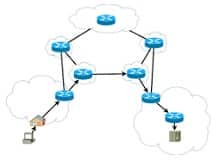The concept of interconnectivity is not part of the dictionary of the Royal Spanish Academy ( RAE ), where the term connectivity does appear: the ability to establish connections or connect . The idea of connecting, for its part, refers to achieving communication between two elements or linking two systems or devices together .
 Starting from these ideas we can move forward with the definition of interconnectivity. The notion, frequently used in the field of computing , is linked to communication between two or more networks .
Starting from these ideas we can move forward with the definition of interconnectivity. The notion, frequently used in the field of computing , is linked to communication between two or more networks .
Thanks to interconnectivity, it is possible to share resources, overcome the limitation of nodes and instantly access shared databases. To ensure that two networks are interconnected, equipment such as a hub , a switch or a router , among others, is needed.
It is important to keep in mind that various services and technologies come into play in interconnectivity that allow the design, development and maintenance of networks that are heterogeneous. Interconnection devices are responsible for sending and receiving data through the communication structure that is created from the union of two or more networks.
Interconnected networks maintain their identity, but are suitable for the exchange of resources and data. The difficulties that arise due to the different properties of each network are overcome by interconnection equipment and services .
In the same way, we cannot ignore that there is currently an important series of pillars and actions regarding interconnectivity. Specifically, among the most interesting are some such as these:
-WAN trunk calls. These have the peculiarity that they are much faster.
-Network security is not only essential but must also be really strict in order to facilitate and ensure that this interconnectivity is done with all the guarantees of success and without risks of any kind.
-What is known as IP Telephony also gains importance, which represents significant cost savings.
-No less significant are virtual private networks (VPN), which make use of what are encrypted to allow operation through private WANs with the greatest possible security.
The relevance of interconnectivity, in short, is given by the possibility of relating heterogeneous networks without limitations of transmission power, bandwidth or packet size.
Likewise, the existence of the book “Network interconnectivity technologies” must be established. This work, which was published in 2001 and is written by Merrilee Ford, is the guide needed to understand the bases that serve as fundamental pillars of current interconnectivity technologies.
Along the same lines is also the book “Network interconnectivity with TCP/IP: Design and Implementation”. This work, for its part, was published in 2000 and is authored by David L. Stevens and Douglas E. Comer.
